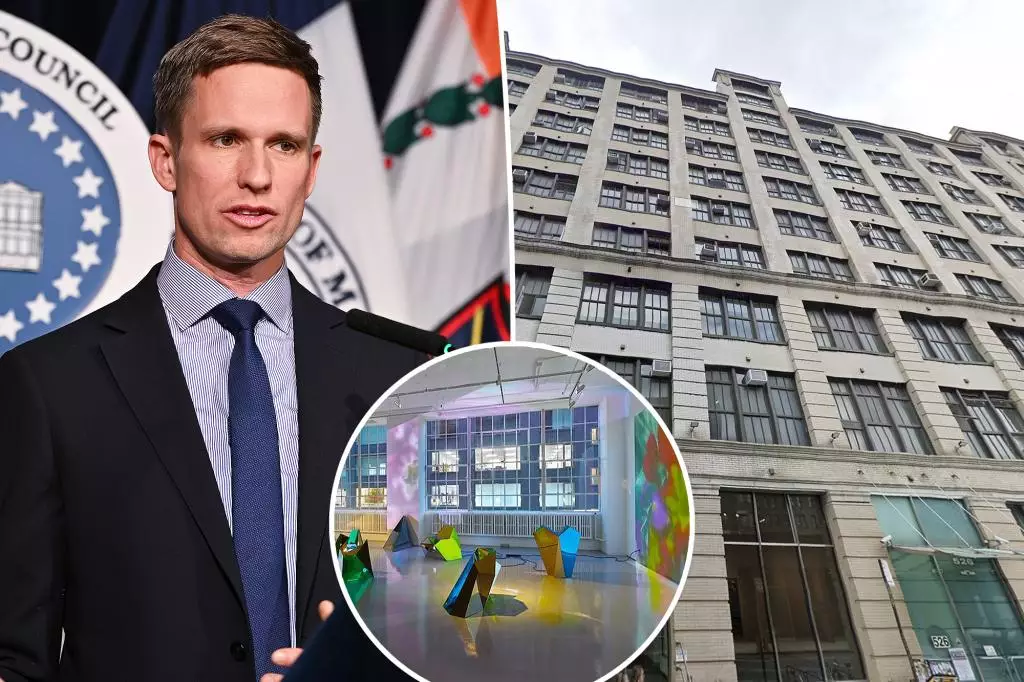In the bustling neighborhood of West Chelsea, a cultural landmark faces an uncertain future. The West Chelsea Arts Building, an establishment recognized for its affordable artist studio spaces, is being put on the market for $170 million following the death of its founder, philanthropist Gloria Naftali. Since its inception in 1993 by Gloria and her late husband Raymond, the building has served as a nurturing ground for creativity, being home to renowned artists like Ross Bleckner and Gary Simmons. Now, local leaders and residents are united in their efforts to prevent this asset from slipping into the hands of real estate developers who may prioritize profits over the neighborhood’s artistic heritage.
The looming sale of the West Chelsea Arts Building has ignited concerns among its tenants and local representatives. The fear is palpable: as real estate demand continues to surge in New York City, artists face potential displacement. City Council member Erik Bottcher has voiced these worries, pointing out that around 200 tenants call the building home, many having established their lives and careers there. Colorfully illustrative of the situation, Bottcher warns, “They are worried that the Naftali Foundation is going to sell this building to the highest bidder with no regard to them. It could mean wholesale displacement.”
The building stands as more than just a cluster of studios; it is a microcosm of the arts community that gives West Chelsea its unique character. Therefore, the stakes are not only economic but also deeply cultural. The area has been recognized as an artist’s haven for hundreds of years, but increasing rents jeopardize its status as a sanctuary for creative minds.
In a bid to safeguard this cherished resource, Bottcher and other key figures—including US Representative Jerry Nadler and State Senator Brad Hoylman-Sigal—have reached out to the Raymond and Gloria Naftali Foundation with an urgent plea. Their letter emphasizes that maintaining the building’s original intended use as a space for artists and galleries is vital for preserving the cultural fabric of New York City. Referencing Gloria Naftali’s will, which expressed a desire for the arts building to remain a haven for creatives, the local leaders are advocating not only for the tenants but for the broader artistic landscape of the city.
Their collective voice exemplifies a community that is not only concerned for its own artists but also aware of the broader implications that the loss of such a hub could have on the city as a whole. By asking for a dialogue with the foundation, they underscore the need for transparency and community engagement in the decision-making process.
On the other side of the conversation lies the Naftali estate, which faces significant financial pressures. Derek Wolman, an attorney for the estate, articulated the foundation’s predicament, stating that they simply lack the necessary funds to maintain the building’s infrastructure. He emphasizes that the sale of this high-profile piece of real estate is aimed at funding causes close to Gloria Naftali’s heart, thus highlighting complex dynamics in play—financial necessity versus cultural responsibility.
Wolman reassures that no immediate evictions are on the horizon. However, as real estate transactions in New York can unfold rapidly, artists are understandably anxious, fearing that their literary and creative endeavors might be uprooted at any moment.
The situation surrounding the West Chelsea Arts Building is a poignant reflection of a larger issue facing urban environments nationwide: the struggle for artists to find affordable spaces in which to live and work. As cities become increasingly gentrified and spaces previously affordable are commoditized, the essence of cultural diversity is threatened. The ongoing concerns raised by tenants and advocates reveal an urgent need for policies that prioritize and protect artistic communities.
While the fate of the West Chelsea Arts Building hangs in the balance, the ongoing dialogue between local leaders and the Naftali Foundation remains crucial. Art is not merely a commodity but a vital aspect of urban life that enriches communities, inspires innovation, and fosters connections. It is imperative that creative spaces like the West Chelsea Arts Building continue to thrive for generations to come, preserving the harmony of art and community in the ever-evolving landscape of New York City.
